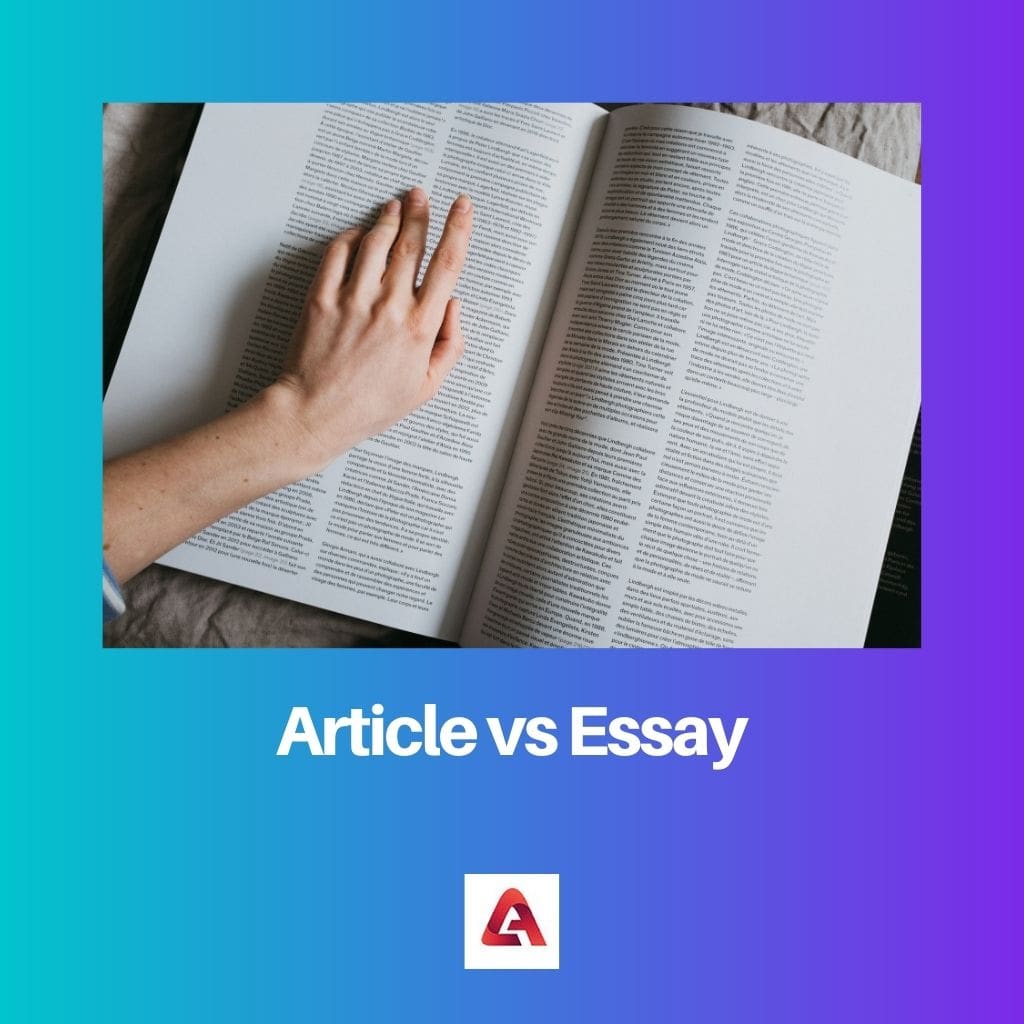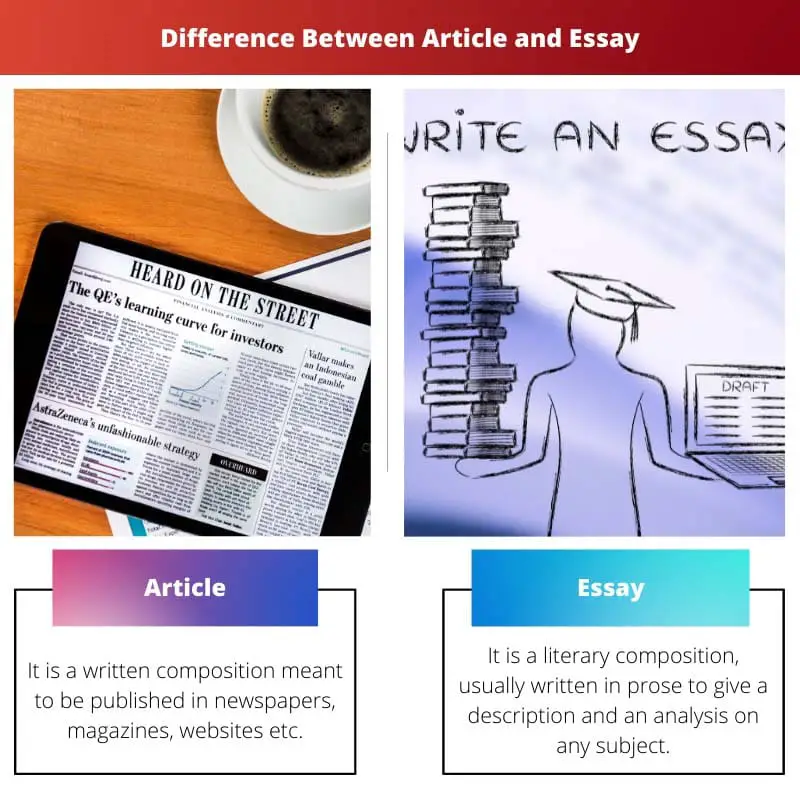Articles and Essays are two different types of Compositions in the English language. They are written for other purposes, have different writing formats, and target a diverse readership.
Key Takeaways
- An article is a piece of writing that provides information, analysis, or commentary on a specific topic, intended for publication in newspapers, magazines, or online platforms; an essay is a more formal, structured piece of writing that presents an argument or analysis on a particular subject, for academic or professional purposes.
- Articles are shorter, more straightforward, and written for a broader audience. At the same time, essays are longer, more in-depth, and targeted toward a specific readership, such as academics or professionals in a given field.
- Both articles and essays are forms of written communication. Still, articles aim to inform, entertain, or provide commentary, while essays present a well-reasoned argument or analysis on a specific topic.
Article vs Essay
An article is a piece of writing that is published in a newspaper, magazine, or website, providing information, analysis, or opinion on a specific topic or issue. An essay is a longer piece of writing that explores a specific topic or idea in more depth and can be formal or informal.

An Article is a written piece meant to be published in print mediums like newspapers, magazines, and journals or an electronic medium like websites. These are written from a neutral point of view, that is, the third person, and are meant for a large readership.
On the other hand, an Essay is a form of literary composition through which the writer or narrator expresses their views or opinions on a particular topic or question. Such expression may be overt or covert. However, the term Essay is used to cover any literary composition.
Whether it is meant for sharing information or expressing one’s personal views, or simply narrating a story doesn’t matter.
Nonetheless, an Essay differs from other literary compositions because it follows a particular line of thought that is ordered, coherent, and reflects the writer’s mind.
Comparison Table
| Parameter of Comparison | Article | Essay |
|---|---|---|
| Definition | It is a written composition to be published in newspapers, journals, magazines, websites, etc. | It is a literary composition, written in prose, to describe and analyze any subject. |
| Point of view | Objective | Subjective |
| Readership | Written with a target readership in mind. | They are not written with a specific readership in mind. |
| Accompanied by | Statistical data, reports and charts, photographs, etc. | No photographs, charts, reports, etc., are required. |
| Format | Subheadings are required. Citations are not necessary. | Subheadings are not used. References and Citations are required. |
What is Article?
An Article is a form of composition written for a large readership to disseminate information on a particular topic. It is meant to be published in print or electronic media.
It tends to be objective and based on facts and is written in the third person.
An article’s theme or topic can be based on current issues or a subject of the writer’s interest. However, it is meant to catch the reader’s attention and, therefore, uses conspicuous headings and subheadings.
Some of the objectives of writing an article are:
- To bring out specific themes and subjects to the reader’s attention.
- To share information on particular topics and issues.
- To give suggestions and advice.
- To persuade the readers to think in a certain way keeping in mind the facts and information presented.
- To discuss certain persons, issues, places, stories, etc.
The following steps are to be followed while writing an article:
- Title/Heading: A title should be given to arrest the reader’s attention, which needs to be brief yet suggestive of the article’s theme.
- Introduction: The opening part must distinctly give a brief outline of the topic so that the article’s theme is intelligible to the readers. Also, a strong opening statement addressing the readers may serve as a plus point.
- Body: It is the central portion of the article and is supposed to give an elaborate description and explanation of the article’s theme. While dealing with this part, the ideas and thought process of the writer must be as straightforward as possible so that the information presented in the article is perceptible to the readers.
- Conclusion: It is the end of the article and is supposed to summarize the argument presented throughout it with a comment or a suggestion.

What is Essay?
It is a form of literary work written in prose and tends to express one’s ideas and views on a particular subject. In its present form, the term has been derived from the French word essayer, which means ‘to try or attempt.’
It was first used by Michel de Montaigne (1533-1592) – a French author who used the term to refer to his literary works. He said these were ‘attempts’ on his part to express his views and ideas.
However, the term’s origin can be traced back to the Latin word exagium, meaning ‘to present one’s case.’ Therefore, composing an essay involves stating the reasons behind a particular case or an argument through analysis, contemplation, and interpretation.
Essays may be formal, exhibiting characteristics like seriousness, unity, dignity, and orderly organization, or informal showcasing features like individuality, humor, sophisticated style, and novelty.
The composition of an essay is a creative and continuous process. So, it cannot be restricted within a particular structure.
However, following a basic structure to keep the unity and orderly arrangement of a particular line of thought intact is beneficial.
That would make the essay perceptible and exciting for the readers.
The following are the components of an essay:
- Title: It should be brief but suggestive of the theme of the Essay.
- Introduction: The introductory part must be eye-catching and pertinent to the subject. It can be made interesting using proverbs, quotations, a brief story, or a general remark leading up to the subject.
- Body: This is the central portion of the essay. The house to which the introduction is the front door, and the conclusion is the back door or exit. While dealing with this part, one should ensure that due weight is given to each paragraph. They should be related to one another and logically arranged to reflect consistency and continuity in the presented line of thought.
- Conclusion: It is essential to make this part effective and satisfying. For that, the arguments presented in the essay must be summed up with a conclusion comprising a quotation or a striking expression.

Main Differences Between Article and Essay
- Articles and Essays are two different forms of written compositions. An article is written to publish either in print media like newspapers, journals, magazines, etc., or in an electronic medium. At the same time, an essay is written to describe or analyze a particular subject.
- An article is mainly written from an objective point of view; therefore, various views and thoughts are combined in a particular piece of writing. While an Essay reflects the subjective views and opinions of the writer and hence, follows a single and coherent line of thought.
- Various headings and subheadings are used to make an article exciting and readable. However, sub-headings, bullet points, etc., are not used in Essay writing. This is done to provide unity and continuity in the line of thought expressed in the composition.
- Essays are not written with a particular objective or readership in mind. They are written to express particular views, observations, reflections, and criticisms. At the same time, a particular objective and a target readership define an Article and distinguish it from an Essay.
- An article tends to be objective and fact-based and therefore needs to be backed by statistical data, charts, reports, and photographs. Conversely, Essays need citations and references and not be backed by data, reports, and photographs.

